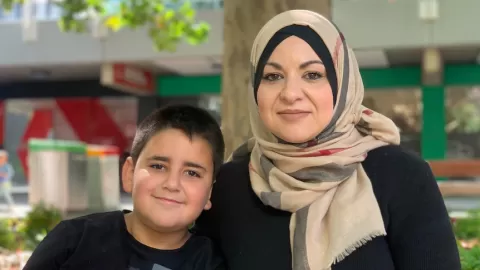
A screening tool developed by Australian researchers has been found to be the world's most effective tool for diagnosing children who are on the autism spectrum.
Key points:
- A study of more than 13,500 Victorian children found the La Trobe University tool to be the most effective in the world
- The tool teaches health workers to use a checklist to identify key behaviours when children come in for routine appointments
- Children as young as 11 months old have been identified as having a higher likelihood of autism
The average age of an autism diagnosis in Australia is between four and five years old but the SACS tools developed at Melbourne's La Trobe University cuts that by more than half, to an average age at diagnosis of 21 months.
Associate Professor Josephine Barbaro, who developed the tool as part of her PhD 15 years ago, said a diagnosis allowed families to access more support, services and therapies.
"That means that their developmental outcomes are improved, their cognition and their language is improved and they also have greater participation in schooling," Dr Barbaro said.
Findings from a five-year study of more than 13,500 Victorian children, published in JAMA Open medical journal, found the tool to be the world's most effective method of diagnosing autism in young children.
Ayoub Ayoub was identified as being at higher risk of autism using the SACS tool when he was 15 months old and was formally diagnosed at 22 months.
Ayoub with his big sister Rania when they were younger.(Supplied: Shafica Berjaoui)
His mother, Shafica Berjaoui, said she was familiar with the diagnosis because members of her family live with autism.
She noticed signs early on, including a "lack of affection" and a delay in hitting milestones.
"I did speak to a couple of professionals in the beginning when he was very young and they were reluctant to maybe take it seriously because he was young," she said.
"Eventually I did cross paths with a paediatrician who was amazing and she heard my concerns and then we were put forward to La Trobe University and the support was downhill from there, it was amazing.
"When the ball started rolling, I felt like I had a voice and people were taking it seriously."
Ms Berjaoui said getting the diagnosis made a huge difference because they could access funding for speech therapy, psychology and occupational therapy.
"I felt a relief. It solidified my concerns, it made it more real and it made the support that I needed for him available," she said.
"He's developed into a very gentle young giant."
Tool identifies 96 per cent of children by preschool age
Every Victorian child attending a routine health check at 12, 18 and 24 months is already screened using the SACS-R tool, after the Victorian government funded training for maternal and child health nurses in 2019.
The added SACS-Preschool tool can be used at the 3.5-year health check to increase the effectiveness of the identification process – though training for that is not currently funded in Victoria.
The tool is also used in some other parts of Australia, as well as in 10 other countries, including Nepal and Bangladesh, but additional funding could see it rolled out more widely.
Associate Professor Josephine Barbaro is part of La Trobe University's Olga Tennison Autism Research Centre (OTARC).(ABC News: Leanne Wong)
Dr Barbaro said the tool involved training maternal child health nurses, or general practitioners, to use a checklist when a child attends routine appointments.
"There are about 12 to 15 behaviours at each check. However, we focus on five key behaviours that are the most predictive of an autism diagnosis and those behaviours do involve observing a child's use of eye contact, of imitating, of responding to names, of engaging in social smiles," Dr Barbaro said.
"We're not adding any additional time to a nurse's check or a general practitioner's check unless they are identifying issues with that child's development."
Once a child is identified as having a higher likelihood of autism, they are referred to the La Trobe University team for an autism assessment.
"Of all children who are identified as high likelihood on this tool, 83 per cent of them go on to have a diagnosis when they're identified as infants or toddlers," Dr Barbaro said.
"By preschool age, we pick up 96 per cent of all children on the autism spectrum with these tools."
She said children as young as 11 months old had been identified using the tool.
"If you're an expert in the field and a child's presentation is very clear then you can make a diagnosis at 12 months but most people will wait until 18 to 24 months for a diagnosis," she said.
"We diagnosed many children by 18 months of age, some children younger than that, but the key is that we identified these children as early as 11 months so we could start that diagnostic process as early as possible."